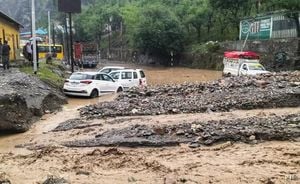Across the globe, January and February have brought unusually warm temperatures, particularly evident in India where regions like Odisha and Kerala are experiencing record-breaking heat. Bhubaneswar, the capital city of Odisha, reached staggering temperatures of 34.9 degrees Celsius just as February began, leading to widespread discomfort and concern among residents.
On February 3, 2025, Bhubaneswar's temperature set the tone for what appears to be another exceptionally hot year. The rising warmth has broken past records; previous years recorded maximums around 30-32 degrees during this period. According to local meteorological records, January 2025 saw Koraput breaking maximum January temperatures after 52 years. Bhawanipatna and Jharsuguda also reported significant spikes earlier, highlighting the trend of increasing temperatures.
What is alarming about this trend is its early onset – last year, Bhubaneswar recorded 40 degrees and remained blisteringly hot for 16 consecutive days by April, the highest tally seen since 1947. With records repeating themselves this February, the residents are already feeling the heat. “It’s becoming unbearable early this year,” lamented one local resident.
Shifting the spotlight to Kerala, another region struggling with severe heat, temperatures have soared abnormally high due to the aftereffects of the El Niño phenomenon, which has left lasting impacts on local weather patterns. The India Meteorological Department (IMD) attributes this rise partially to the sun's movement northward, which usually tends to bring sweltering temperatures earlier than expected. On January 31, 2025, Kannur and Kottayam recorded extreme highs of 36.6 degrees Celsius and 36.5 degrees Celsius respectively.
Even with February just beginning, the Kerala State Disaster Management Authority (KSDMA) has already issued advisories for outdoor workers, urging them to exercise caution against heat-related illnesses. The rising temperatures are impacting various sectors, including agriculture, energy distribution, and even tourism. Farmers are advised to work during the cooler hours of early mornings or late evenings to mitigate the effects of the harsh midday sun.
“January has set records for heat, and we are expecting 2025 to break more,” said IMD senior scientist VK Mini, pointing to the broad trends visible across the state. Traditionally, the peak temperature season for Kerala was confined to March and April, but the past two years have indicated this is changing—spiking as early as January.
Munnar, famous for its cooler climates and lush tea plantations, is one of the few areas experiencing cooler weather recently, recording temperatures as low as zero degrees Celsius on February 1, 2025. This stark difference highlights the variance experienced within Kerala, as other regions suffer under oppressive heat. The IMD suggests this shift signals not just unusual seasonal changes but potentially more significant long-term effects on Kerala’s climate.
The combination of high temperatures and humidity has resulted in increased incidents of heat-related health issues. Reports from the Kerala health department show spikes in illnesses like heatstroke and dehydration. Vulnerable populations, including young children and the elderly, are particularly at risk during these soaring temperatures. Experts warn of the urban heat island effect, whereby cities become significantly warmer than surrounding areas due to human activity and infrastructure density.
Excessively high temperatures are also affecting substantially the agricultural cycles. Changes in temperature have delayed the maturation of certain crops, increasing their risks of failure. Notably, paddy, which matures typically within 120 days, now may require up to 160 days, compounding the struggles farmers face with fluctuated weather patterns. The flowering cycles for various vegetables are also showing instability, pushing farmers to rethink traditional agricultural practices.
Agricultural adaptation is necessary but complicated as changing patterns demand relentless flexibility. “The predictions are grim,” noted Gopakumar Cholayil, climate scientist from Kerala Agricultural University. The unpredictability of rainfall and heatwaves creates significant challenges for farmers, already overwhelmed by fluctuated market prices and the adverse effects of warming soil conditions.
Initiatives to develop climate-resilient crops and improve predictive weather capabilities are becoming urgent. KSDMA officials state they are working on strategies to cope with these increasing weather phenomena. Unlike recent years, which focused on recovery strategies after disasters, there is now growing recognition of the need for proactive measures.
The effects of climate change are not distant threats but immediate realities for weather-affected regions. While some Southern districts may see brief showers, they are unlikely to significantly alter the harsh circumstances experienced elsewhere. The IMD warns of persistent high temperatures across all boundaries, hinting at extended bouts of unseasonable heat.
Kerala's rising temperatures and resultant climate concerns reflect broader trends visible not only within India but worldwide. This year's early heat signals symptoms of larger, potentially perilous climatic shifts, emphasizing the need for greater awareness and actionable environmental policies. It raises pressing questions about how much longer communities can adapt without substantial changes to their agricultural practices and daily life.



